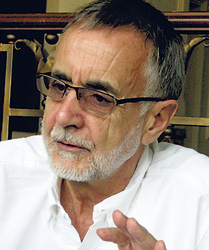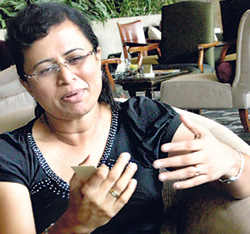Battle-ready not weary, the final push towards malaria-elimination is now on and an important meeting was held in Kandy recently not only to consolidate gains but also to share experiences and go ahead with mopping up operations.
The Asia-Pacific Malaria Elimination Network (APMEN), the “club” formed to fight the carrier of malaria and its vector comprises Sri Lanka, China, Bhutan, North and South Korea, Malaysia, Indonesia, Solomon Islands, Vanuatu and the Philippines.While the main four-day sessions were on with Health Minister Nimal Siripala de Silva as the chief guest, from February 9-12 at the Earl’s Regency, many were the active working groups which discussed the issues faced by APMEN countries. Collaborative organizations such as the World Health Organization, research institutions and donors also attended the sessions.
 |
| Sir Richard Feachem |
Taking its name from the malaria parasite common in the Asia-Pacific region, the ‘Vivax working group’ focused on the havoc created by it over the years and the need for extensive research, the Sunday Times understands.
This is because there has been much attention on the parasite, Falciparum, commonly found in Africa where malaria is a huge problem, says an eminent professor who was in Sri Lanka to attend the sessions. “There is much less understanding of the Vivax parasite while Falciparum has been studied more.”
Explaining that although Falciparum is also present in Asia, Sir Richard Feachem, Professor of Global Health and Director, Global Health Group of the University of California, San Francisco, stresses that the bigger problem is Vivax for this region. There was also the ‘Vector working group’ zeroing on the mosquito and exchanging knowledge about this tiny insect while another was the ‘Fellowship programme’ under which those working towards malaria elimination in APMEN countries will compete to go to a different member country to gain practical experience and study how the activity is carried out.
With regard to his role in all this, Sir Richard says that the APMEN Secretariat is managed by the University of Queensland, Brisbane and the University of California, San Francisco, where he is attached to. Although a major part of the funding comes from the Australian government, the co-funding is from the Bill and Melinda Gates Foundation.
To put malaria in context, Sir Richard goes into the past, as far back as the 1900s. At that time all 200 countries in the world had malaria. Now 100 have eliminated the disease (the United States of America doing so soon after World War II and Australia in 1982), with the balance 100, mainly in the tropical belt right around the middle of the globe falling into two categories.
Thirty-five countries, 10 of which are in Asia-Pacific, are on the path to elimination and the other 65 still controlling malaria. The good news, of course, is that Sri Lanka is among those 10 on a successful journey to rid the country of malaria.
“So we are very excited about it,” says Sir Richard.
APMEN formed with a grant of Aus. $ 7 million from the Australian government a year ago, on February 15, had its inaugural meeting in Brisbane, after which Sri Lanka readily agreed to host the first annual meeting this February.
When asked why Australia was interested in helping other countries eliminate malaria, Sir Richard explained that it was because they have been successful in battling the disease and have many collaborations with countries which have not. “Their aid programme is focused on the Asia Pacific region and Prime Minister Kevin Rudd pledged the grant over a four-year period at the UN General Assembly sessions.”
“Malaria control is a lot about management, that is the absolute key,” adds Sir Richard.
Don’t forget what happened in the ’60s warns official
Sri Lanka, ravaged by malaria since the dawn of its civilization (with the ancient kingdoms being forced to move not only due to Cholan invasions but also attacks by the malarial mosquito) is now on the threshold of elimination of this disease.
2014 is the target-year, says Consultant Community Physician Dr. G.N.L. Galappaththy of the National Malaria Control Programme.
Sri Lanka, however, needs to be conscious of the pitfalls which can set the programme back as in the 1960s, the Sunday Times understands.
 |
| Dr. Galappaththy |
Way back in 1963 too the country was close to malaria eradication, with only 17 cases being reported of whom 11 were “importations” from the Maldives, it is learnt. It was a time when not only DDT spraying was successful but anti-malarial drugs were also available.
It was here that a miscalculation occurred – assuming that the disease was under control, the authorities at that time prematurely withdrew the funding and the resources, leading to malaria surveillance suffering a major setback.
“What is needed when a country is close to eradication is not passive but active detection,” stresses Dr. Galappaththy.
Citing an example, she says that usually gem-miners who strike luck in areas such as Elahera go to Kataragama to thank the gods.
That’s what happened in the ‘60s and one miner did go to Kataragama not alone, taking with him malaria as well. But an alert Public Health Inspector did detect the first case of transmission from one part of the country to another, but by the time the systems fell into place, the bus with the diseased miner had left.
By 1968, malaria had spread like wildfire, gripping 400,000 people and felling 84, because people had lost their immunity to it.
The trend continued with 1999 seeing 269,000 cases but surveillance and control bringing it down to 196 in 2007. The disease, however, flared again with 2008 recording 600 and 2009 484 cases.
Why?
The rise in numbers is linked to the advance of the security forces into uncleared areas of the north, the Sunday Times understands, with 380 of the 484 cases being such personnel and the balance civilians while 21 were “imported”.
“There is a very strong historical relationship between malaria and advancing armies,” says Sir Richard, adding that most armies and malaria go hand in hand. Some armies have regulations even leading up to court-martialling, he says, explaining that during the Vietnam War, it was mandatory for American troops to take their medication to prevent malaria.
The security forces are very cooperative, says Dr. Galappaththy, playing an active role in the screening of their personnel and also spraying insecticides in camps.
There is strong surveillance with new technology and a network of computers, set up with funds from the Global Fund, links the districts. This is vital because in the “control phase” there may be passive detection but in the “elimination phase” it has to be active, according to Dr. Galappaththy, who quotes the Sinhala phrase, “rogeen pasu pasa hamba yanawa”.
There are no concerns, however, because the authorities headed by Minister de Silva are supporting the elimination effort 100%.
Once malaria is eliminated from Sri Lanka, a sharp eye would need to be kept on importation from other countries, it is learnt.
Except the Maldives, where it has already been eliminated, all those coming in from countries such as Nigeria and Tanzania (where many Sri Lankans work), Liberia (where Sri Lankans have been deployed as peace-keepers) and India from where people travel to and fro regularly need to be screened. The danger is that not only the parasite but also the vector may smuggle themselves in from India, it is understood.
The National Malaria Control Programme has already geared itself to meet the challenges after elimination by carrying out screening at the entry points in Mannar, Trincomalee and Jaffna, says Dr. Galappaththy, adding that plans are underway to set up a “malaria room” at the airport in Katunayake to test people suspected of having the disease.
With elimination will come the need to identify the parasite and keep it in a bank and then constantly check whether a mutation or a new strain is emerging, while also stocking up on anti-malaria drugs.
The advancement in technology will also be used, says Dr. Galappaththy, pointing out that if there is a fever of unknown origin, just a pinprick would help confirm malaria, in 15 minutes through the Rapid Diagnostic Test Kit which could even be used at home, cutting down the need for good equipment in the form of microscopes and trained microscopists.
While keeping the locals free of malaria and also reducing the labour hours lost due to illness and resources expended on treating the ill, a Sri Lanka sans malaria would be a bigger attraction to tourists. |



